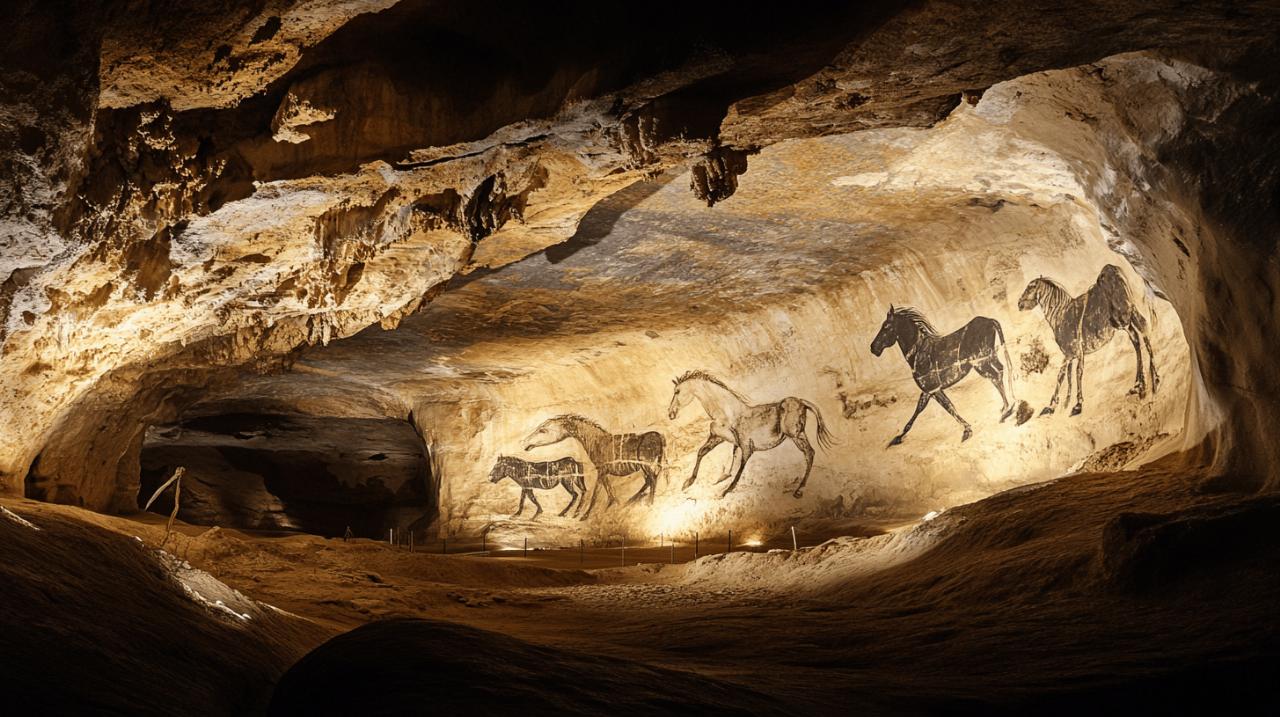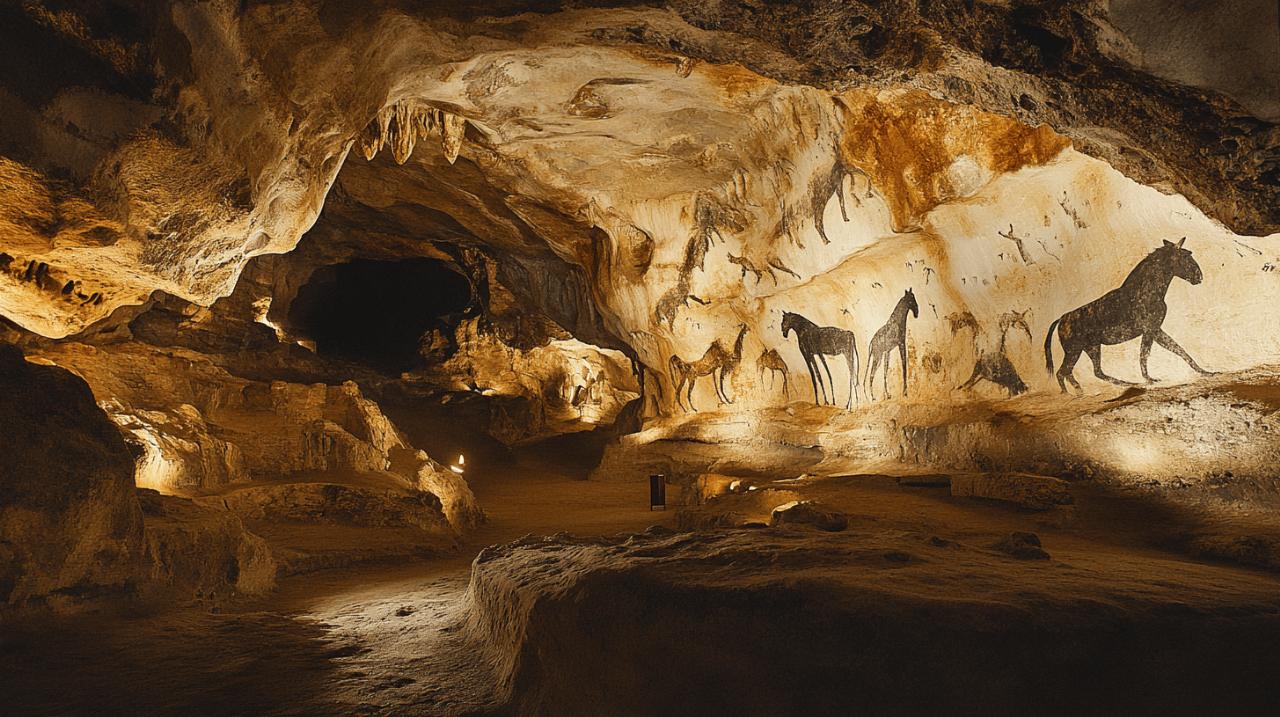Experience a Time Travel to the Chauvet 2 Cave in Ardèche: Understanding Animal Symbolism in Palaeolithic Art
Imagine stepping back over thirty thousand years in time to witness the extraordinary artistry of our earliest ancestors. The Chauvet 2 Cave in the Ardèche region of France offers precisely this opportunity, serving as a meticulously crafted replica of one of the world's most significant prehistoric sites. Nestled near Vallon-Pont-d'Arc, this remarkable destination invites visitors to explore the enigmatic world of Palaeolithic cave paintings and the profound symbolism embedded within them. Far from being a mere museum, this experience transports you into the very heart of Aurignacian civilisation, revealing the spiritual and cultural depths of early Homo sapiens who once roamed the landscapes of southern France.
The magnificent replica: discovering chauvet 2 cave and its prehistoric treasures
The Journey to Vallon-Pont-d'Arc and the Ardèche Gorges
Reaching the Chauvet 2 Cave is an adventure in itself, one that blends modern convenience with the anticipation of uncovering ancient secrets. The Ardèche region is accessible from several major cities, making it a feasible excursion whether you are travelling from Marseille, Lyon, Valence, or even Paris. High-speed TGV trains connect these urban centres to nearby stations, from which a short drive through the stunning Ardèche gorges brings you to Vallon-Pont-d'Arc. This charming town is famed for its natural stone arch bridge, a geological wonder that has captivated visitors for centuries. The journey through the verdant valleys and dramatic limestone cliffs sets the stage for the historical voyage that awaits within the cave itself. The surrounding area also offers additional attractions, such as Vals-les-Bains, ensuring that your trip to the Ardèche becomes a multi-faceted exploration of both natural beauty and human heritage.
What makes this unesco world heritage site truly special
The original Chauvet Cave was discovered on the eighteenth of December in nineteen ninety-four by Jean-Marie Chauvet, Éliette Brunel, and Christian Hillaire. This discovery unveiled a treasure trove of prehistoric rock art that astonished archaeologists and art historians alike. The cave paintings, dated between thirty thousand and thirty-three thousand years old, are celebrated not only for their remarkable age but also for their exceptional aesthetic quality. Unlike many other Palaeolithic sites, the Chauvet Cave features an unusually high number of predatory animals, including lions, panthers, bears, rhinoceroses, and hyenas, alongside depictions of thirteen different species. Human figures are rare, with one notable exception being a mysterious image known as 'The Sorcerer'. The original cave remains heavily protected to prevent the kind of deterioration that has plagued other sites, such as Lascaux Cave, which suffered damage from fungus and mould. The Grotte Chauvet 2, therefore, serves as a faithful replica, allowing the public to experience the splendour of these ancient artworks without compromising their preservation. Recognised as a UNESCO World Heritage Site, this replica is a testament to the ingenuity and reverence with which we regard our ancestral culture.
Decoding the Ancient Gallery: Animal Symbolism in Aurignacian Cave Art
The symbolic meaning behind the painted creatures
Understanding the animal symbolism within Palaeolithic cave art requires delving into the minds of the Aurignacian people who created these images. The prevalence of predatory animals in the Chauvet Cave suggests that these creatures held profound significance in the spiritual and daily lives of early Homo sapiens. It is believed that these depictions were not merely decorative but served as expressions of reverence, fear, or perhaps a desire to harness the power and characteristics of these formidable beasts. The lions, bears, and panthers that dominate the cave walls may have symbolised strength, courage, and survival in a harsh and unpredictable environment. Some researchers, including Jean Clottes who led the first research team in nineteen ninety-eight, emphasise the importance of interpreting these images within their cultural context. The art may have been tied to shamanistic rituals or served as a means of communicating with the spirit world. The scarcity of human figures further underscores the focus on the animal kingdom, suggesting that the natural world and its inhabitants were central to the Aurignacian worldview. This symbolic language, painted thousands of years ago, continues to resonate today, offering glimpses into the beliefs and values of our distant ancestors.
Understanding palaeolithic artistic techniques and spiritual beliefs
The techniques employed by the Aurignacian artists reveal a sophisticated understanding of form, movement, and perspective. The cave paintings in Chauvet 2 showcase a variety of methods, including engraving, drawing, and painting, often utilising natural pigments such as ochre and charcoal. The artists demonstrated a keen ability to capture the essence of the animals they depicted, using the contours of the cave walls to enhance the three-dimensional quality of their work. This mastery of technique suggests that art was not a casual pastime but a deeply ingrained aspect of Aurignacian culture. The Aurignacian Gallery, an interactive museum within the Grotte Chauvet 2 site, provides visitors with a comprehensive exploration of these artistic practices. Spanning six hundred square metres of permanent exhibits, the gallery features a cinema with sixty-five seats screening films about the Aurignacian period, as well as an immersive pathway lined with models of extinct prehistoric animals. A giant panorama, composed of fifteen hundred photographs, offers a breathtaking visual journey through the landscapes and lifeways of thirty-six thousand years ago. The gallery addresses key themes such as the geological changes in the Ardèche during this era, the identity and origins of the Aurignacians, and the broader context of early European art, sculpture, jewellery, and music. By examining these elements, visitors gain a deeper appreciation for the spiritual beliefs that underpinned the creation of cave art, viewing it not as isolated images but as integral components of a rich cultural tapestry.
Planning Your Visit: A Practical Guide to the Chauvet 2 Experience
Getting There from Marseille, Lyon, and Beyond
 For those planning a visit to the Chauvet 2 Cave, careful preparation ensures a smooth and rewarding experience. As previously mentioned, the Ardèche region is well connected to major French cities by rail and road. Travellers arriving by TGV can disembark at stations in Valence or Lyon, both of which offer rental car services and regional bus connections to Vallon-Pont-d'Arc. The drive through the Ardèche gorges is particularly scenic, with winding roads that follow the course of the river and pass through charming villages and dramatic limestone formations. For visitors flying into France, Marseille and Lyon are the closest major airports, each offering a gateway to the region. It is advisable to book tickets to the Grotte Chauvet 2 in advance, as the site operates on a guided tour system and capacity is limited to protect the integrity of the replica. Information regarding pricing and availability can be found on the official website, ensuring that your visit is both convenient and well-organised. The combination of stunning natural scenery and profound historical significance makes the journey to Chauvet 2 a voyage of discovery that begins long before you step inside the cave itself.
For those planning a visit to the Chauvet 2 Cave, careful preparation ensures a smooth and rewarding experience. As previously mentioned, the Ardèche region is well connected to major French cities by rail and road. Travellers arriving by TGV can disembark at stations in Valence or Lyon, both of which offer rental car services and regional bus connections to Vallon-Pont-d'Arc. The drive through the Ardèche gorges is particularly scenic, with winding roads that follow the course of the river and pass through charming villages and dramatic limestone formations. For visitors flying into France, Marseille and Lyon are the closest major airports, each offering a gateway to the region. It is advisable to book tickets to the Grotte Chauvet 2 in advance, as the site operates on a guided tour system and capacity is limited to protect the integrity of the replica. Information regarding pricing and availability can be found on the official website, ensuring that your visit is both convenient and well-organised. The combination of stunning natural scenery and profound historical significance makes the journey to Chauvet 2 a voyage of discovery that begins long before you step inside the cave itself.
What to Expect During Your Guided Tour of the Galerie
Upon arrival at the Grotte Chauvet 2, visitors are greeted by knowledgeable guides who lead small groups through the meticulously recreated cave chambers. The tour is designed to be both informative and immersive, with lighting and soundscapes that evoke the atmosphere of the original Palaeolithic site. As you walk through the replica, you will encounter the breathtaking panels of animal paintings, each one a testament to the skill and vision of the Aurignacian artists. The guides provide context and interpretation, explaining the techniques used to create the images and the possible symbolic meanings behind them. After exploring the cave, visitors proceed to the Aurignacian Gallery, where the cultural and historical background of the artworks is brought to life. The interactive exhibits and cinema presentations offer a comprehensive understanding of who the Aurignacians were, how they lived, and the significance of their artistic achievements. The models of extinct prehistoric animals, including mammoths and cave bears, allow visitors to visualise the world in which these early humans existed. The entire experience is designed to be accessible and engaging for visitors of all ages, making it an ideal family adventure. The blend of education and immersion ensures that every visitor leaves with a deeper appreciation for the ingenuity and creativity of our earliest ancestors.
A Brilliant Family Adventure: Making the Most of Your Time Travel Experience
Why Chauvet 2 Is Perfect for Visitors of All Ages
The Chauvet 2 Cave offers an experience that transcends age and background, making it an excellent choice for family outings and educational trips. Children and adults alike are captivated by the vivid depictions of prehistoric animals and the opportunity to step into a world that existed tens of thousands of years ago. The interactive nature of the Aurignacian Gallery, with its models, panoramas, and films, ensures that younger visitors remain engaged and inspired throughout their visit. The guided tours are carefully paced to accommodate diverse audiences, and the guides are skilled at answering questions and fostering curiosity. For families seeking to combine entertainment with education, Chauvet 2 provides a unique opportunity to explore themes of human evolution, artistic expression, and environmental adaptation in a setting that is both authentic and accessible. The site's commitment to preservation and heritage protection, supported by organisations such as the Bradshaw Foundation, underscores the importance of sharing this global heritage with future generations. By visiting Chauvet 2, families contribute to the ongoing effort to document and protect ancient rock art around the world, ensuring that these irreplaceable cultural treasures are preserved for years to come.
Combining Your Visit with Other Ardèche Attractions and Scenic Spots
The Ardèche region offers a wealth of attractions beyond the Chauvet 2 Cave, making it possible to extend your visit into a broader exploration of southern France. The natural arch at Vallon-Pont-d'Arc is a must-see, providing stunning views and excellent opportunities for photography. The Ardèche gorges themselves are ideal for outdoor activities such as canoeing, hiking, and rock climbing, allowing visitors to immerse themselves in the same landscapes that inspired the Aurignacian artists. Nearby, Vals-les-Bains offers thermal baths and spa facilities, perfect for relaxation after a day of exploration. The region is also home to other prehistoric sites, including the sculpted rock shelters that date back fifteen thousand years, as well as the Cosquer Cave, which features artworks from twenty-one thousand years ago. Although Lascaux Cave is further afield, it remains a notable comparison, showcasing the diversity and richness of Palaeolithic art across France. The combination of cultural heritage, natural beauty, and outdoor adventure ensures that a trip to the Ardèche is both enriching and memorable. Whether you are drawn by the allure of ancient art, the charm of French villages, or the majesty of the gorges, the Ardèche promises an experience that resonates long after your journey ends.
